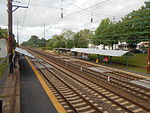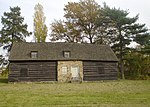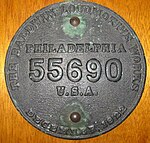The Delaware Valley, sometimes referred to as Greater Philadelphia or the Philadelphia metropolitan area, is a metropolitan region in the Northeast on the East Coast of the United States that centers on Philadelphia and spans four U.S. states: southeastern Pennsylvania, southern New Jersey, northern Delaware, and the northern Eastern Shore of Maryland. As of the 2020 census, the core metropolitan statistical area of the Delaware Valley had a total population of 6.288 million residents, making it the nation's seventh-largest, the continent's eighth-largest, and the world's 35th-largest metropolitan area. The combined statistical area of the Delaware Valley is even larger with a total population of 7.366 million.
The Delaware Valley's urban core is Philadelphia, the nation's 6th-most populous city. Other major urban population centers in the region include Reading, Upper Darby Township, and Chester in Pennsylvania; Atlantic City, Camden, Vineland, and Cherry Hill in New Jersey; and Wilmington and Dover in Delaware. Philadelphia metropolitan area has a gross domestic product (G.D.P.) of $431 billion, the ninth-largest among U.S. metropolitan areas.
The Delaware Valley has been influential in the nation's history and economy. The area has been home to many people and sites significant to American culture, history, and politics. Philadelphia is sometimes known as "The Birthplace of America", since both the Declaration of Independence and the Constitution were drafted and signed in the city. The Delaware Valley was home to many other instrumental moments during the American Revolution, and Philadelphia served as the nation's first capital for most of the 18th century until construction of the nation's capital in Washington, D.C., in 1800. Both the Declaration of Independence and U.S. Constitution were signed and ratified in Independence Hall in Philadelphia in 1776 and 1789, respectively.
The Delaware Valley is one of the nation's leading regions for academia and academic research with a considerable number of globally-known and highly ranked universities, including the University of Pennsylvania, Drexel University, Thomas Jefferson University, Rowan University, Villanova University, Saint Joseph's University, Temple University, Rutgers University–Camden, La Salle University, the University of Delaware, Stockton University, and others. Philadelphia and the Delaware Valley are a biotechnology hub. As of 2023, metropolitan Philadelphia had entered the ranks of the top five U.S. venture capital centers, facilitated by its relative proximity to the New York metropolitan area and its entrepreneurial and financial ecosystems. In addition, South Jersey and the wider Philadelphia metropolitan area have become a U.S. East Coast epicenter for logistics and warehouse construction.









